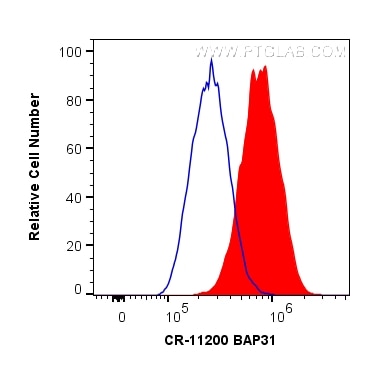- Featured Product
- KD/KO Validated
Cardinal Red™-conjugated BAP31 Polyclonal antibody
BAP31 Polyclonal Antibody for FC (Intra)
Host / Isotype
Rabbit / IgG
Reactivity
human, mouse, rat
Applications
FC (Intra)
Conjugate
Cardinal Red™ Fluorescent Dye
Cat no : CR-11200
Synonyms
Validation Data Gallery
Tested Applications
| Positive FC detected in | HeLa cells |
Recommended dilution
| Application | Dilution |
|---|---|
| Flow Cytometry (FC) | FC : 0.20 ug per 10^6 cells in a 100 µl suspension |
| It is recommended that this reagent should be titrated in each testing system to obtain optimal results. | |
| Sample-dependent, Check data in validation data gallery. | |
Product Information
CR-11200 targets BAP31 in FC (Intra) applications and shows reactivity with human, mouse, rat samples.
| Tested Reactivity | human, mouse, rat |
| Host / Isotype | Rabbit / IgG |
| Class | Polyclonal |
| Type | Antibody |
| Immunogen | BAP31 fusion protein Ag1668 |
| Full Name | B-cell receptor-associated protein 31 |
| Calculated Molecular Weight | 28 kDa |
| Observed Molecular Weight | 28 kDa |
| GenBank Accession Number | BC014323 |
| Gene Symbol | BCAP31 |
| Gene ID (NCBI) | 10134 |
| Conjugate | Cardinal Red™ Fluorescent Dye |
| Excitation/Emission Maxima Wavelengths | 592 nm / 611 nm |
| Form | Liquid |
| Purification Method | Antigen affinity purification |
| Storage Buffer | PBS with 50% Glycerol, 0.05% Proclin300, 0.5% BSA, pH 7.3. |
| Storage Conditions | Store at -20°C. Avoid exposure to light. Stable for one year after shipment. Aliquoting is unnecessary for -20oC storage. 20ul sizes contain 0.1% BSA. |
Background Information
BAP31 is a chaperone protein that is abundant in the endoplasmic reticulum (ER). BAP31 plays a role in the export of secreted proteins in the ER, the recognition of abnormally folded protein and their targeting to the ER associated-degradation (ERAD). It also serves as a cargo receptor for the export of transmembrane proteins. BAP31 may be involved in apoptosis.
Protocols
| Product Specific Protocols | |
|---|---|
| FC protocol for Cardinal Red™ BAP31 antibody CR-11200 | Download protocol |
| Standard Protocols | |
|---|---|
| Click here to view our Standard Protocols |


